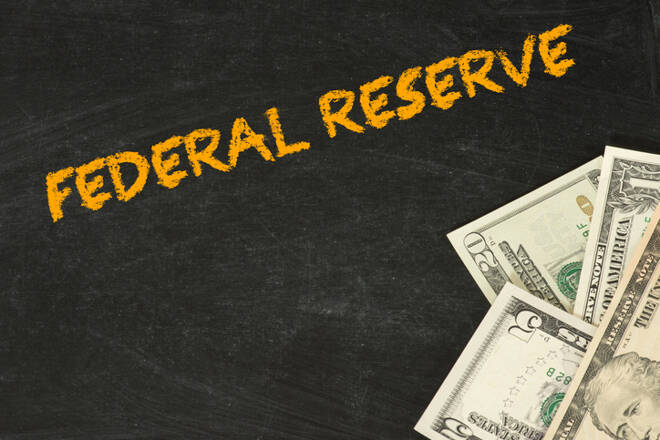Advertisement
Advertisement
Investors Betting Fed Will Take More Dovish Approach To Rates
By:
The Fed didn’t surprise anyone with its decision to leave rates unchanged in June, traders had placed only a 20% probability on a rate cut, but the split vote tells investors that a cut is on the way, and its increasingly likely that will be in July, as the price action in the Treasury, gold and stock markets tells us.
Federal Reserve policymakers spoke and the markets listened on Wednesday. With investors interpreting their interest rate decision several ways.
Treasury investors seemed to think the Fed got it wrong. They drove U.S. 10-year Treasury yields below 2% for the first time since November 2016. Stock investors liked the news, but we don’t know how much of the strength was due to the hope of a trade deal. Gold traders and U.S. Dollar investors think the Fed was dovish.
As far as the highlights of the Fed’s interest rate decision, monetary policy statement and economic projections are concerned:
- On Wednesday, the Federal Open Market Committee (FOMC) voted 9 to 1 to keep the benchmark rate in a target range of 2.25% to 2.50%.
- The Fed dropped the word “patient” in describing its approach to policy.
- Central bankers also left the door open somewhat to future cuts.
- Powell said during a post-meeting press conference that some officials believe the case for accommodation had “strengthened.”
FOMC Votes 9 to 1 Against Rate Cut
Despite a divided Federal Reserve indicating formally that no cuts are coming in 2019, the markets are still betting the Fed cuts, as soon as July. The Fed didn’t surprise anyone with its decision to leave rates unchanged in June, traders had placed only a 20% probability on a rate cut, but the split vote tells investors that a cut is on the way, and its increasingly likely that will be in July, as the price action in the Treasury, gold and stock markets tells us.
Fed Changes Language in Monetary Policy Statement
The FOMC acknowledged those worried about slower economic growth by dropping the word “patient” in describing its approach to policy. This was a clear signal to investors that the Fed was taking a more dovish approach to rates.
The Fed’s monetary policy statement also changed wording to concede that inflation is “running below” the central bank’s 2% objective. In their forecast for headline inflation this year, policymakers slashed the estimate to 1.5% from March’s 1.8%. Core inflation, which excludes food and energy prices, is likely now to be 1.8% from March’s 2%, according to the quarterly summary of economic projections also released Wednesday.
The FOMC changed language from its May statement to indicate that economic activity is “rising at a moderate rate,” a downgrade from “solid.”
Baseline Scenario Tweaks
In their baseline scenario, FOMC members said they still expect “sustained expansion of economic activity” and a move toward 2% inflation, but realize that “uncertainties about this outlook have increased.’
“In light of these uncertainties and muted inflation pressures, the FOMC will closely monitor the implications of incoming information for the economic outlook and will act as appropriate to sustain the expansion, with a strong labor market and inflation near its symmetric 2 percent objective,” the statement said. The “act as appropriate to sustain the expansion” language mirrors a statement from Powell in early June.
The committee acknowledged the “strong” labor market and characterized it as “solid’. It also said that household spending “appears to have picked up from earlier in the year.”
The “Dot Plot”
According to the “dot plot” of individual members’ expectations, eight members favor one cut this year while the same number voted in favor of the status quo and one still wants a rate hike.
Into 2020, the Fed consensus was a bit stronger, with nine members wanting a cut to a funds rate around 2.1%. The direction changes, though, in 2021, with indications of an increase of about a quarter-point, culminating in an expected long-run value of 2.5%.
This assessment strongly contrasts with market expectations. The probability for a July easing rose to 82.5% and the chances of a second cut in December were most recently 60.4%. Investors expect a third cut in March of 2020.
Powell Strongly Hints at Future Cuts
Finally, Powell opened the door to the possibility of a rate cut as soon as July in his press conference. He said, “Many participants now see the case for somewhat more accommodative policy has strengthened.”
Powell further added, “Overall, our policy discussions focused on the appropriate response to the uncertain environment,” he said. “Many participants believe that some cut to the fed funds would be appropriate in the scenario they see as most likely.”
About the Author
James Hyerczykauthor
James Hyerczyk is a U.S. based seasoned technical analyst and educator with over 40 years of experience in market analysis and trading, specializing in chart patterns and price movement. He is the author of two books on technical analysis and has a background in both futures and stock markets.
Advertisement
